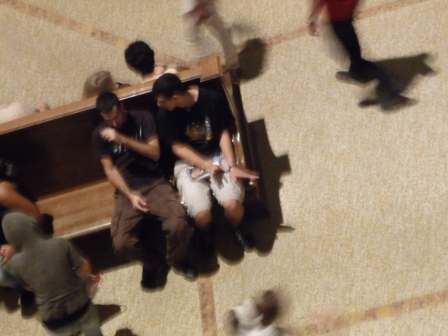First day of the final week. It’s all gone by so fast. I could do this for a long long time!
Miles Stroth is our teacher this week.
4 kinds of scenes:
- straight / absurd scene (one straight acting person, one absurd person)
- character driven scene
- realistic scene
- 4th type to come tomorrow morning!
| sign on n clark “cheap and tacky 2 bedrooms”. everyone would want to live there, right? |
characteristics of the straight/absurd scene
- you are pretending to be yourselves or close to yourself
- one person is “wrong” or flawed
- if you stagnate, then answer the who are these guys to each other, the why are they doing this – get the game of the scene (straight/absurd), and then heighten with who what where
the absurd character in a straight/ absurd scene
- the absurd one is the one who is “wrong” or “flawed” (you stole the cheese from the fridge, you are the one who forces people to wear things they don’t want to or you are emotionally stunted)
- absurd character’s job: do it more, keep on doing the “wrong” thing, play your flaw
- offer absurd nonsensical reasons for why you do things (don’t ever justify it in a logical way),
- ignore any of the straight person’s offers which don’t suit you
- listen opportunistically for things which serve you, ignore what doesn’t – if it’s a troublesome or argumentative line just don’t respond or respond with a non-sequitur (let’s get pizza) or rehash info we already have (it’s so cool that i have a monkey).
- if you feel inactive reiterate what you already have (i own a monkey called carl)
- find what to do in what the straight guy says
- absurd is almost always positive state of mind; straight guy gets increasingly frustrated
- our natural instinct is to defend ourselves from attack: to play the absurd reverse it on stage, ignore anything requiring defense
- the absurd does what the straight guy tells you not to do
- some absurds are borderline retards, others are drug-addled
- when you have to give a justification for your behaviour, make it ridiculous (i won’t share my umbrella with you because you’re an orphan)
the straight character
| view from my new york hotel room window |
- straight guy points out everything that’s wrong, absurd guy does absurd stuff
- tell the absurd guy what NOT to do (don’t leave your shoes by the door, clean up the yard, call me mum)
- get increasingly frustrated
- straight man’s job: make it worse, listen to everything because you are trying to build a logical case against the straight guy, and you need all the ammunition
- once you’ve established the absurd guy, you need to take it up a level to why you are still here in this room with this absurd guy (you saved my life in ‘nam)
- straight guy makes sense, absurd guy makes no sense at all
- don’t temper your integrity – keep making it worse for yourself by feeding them stuff to frustrate you
- be obvious
- audience gets into the straight/absurd scene through the straight guy (they think, i’m with you, he IS crazy)
- we need the straight guy to blow up so we can cue a new level (who, what, where, etc) then we can keep the original game and add a new one if we need to. reaction should be progressive leading to a blow out – start small with small offers, but you may go back immediately if it’s a big offer… there must be a level change after a blow out
- straight guy points out what’s generally agreed to be the norm
- absurdities not recognised by the straight guy don’t get the laugh until the straight guy points them out (if you agree with the absurd, then they don’t laugh)
- there’s a version of straight man as victim: you’ve got my jacket, that was my dad’s jacket, i felt safe when i wore it, he’s dead now, it was really comforting when i went through chemo to wear that jacket…
- straight guy can give a reasonable explanation for the absurd’s behaviour – the absurd cannot
- generally work under the assumption that you know this person, so their behaviour isn’t happening for the first time, so you don’t have to blow up immediately – take it slow
characteristics of a character driven scene
- if you choose character-driven, stay in it, don’t switch to absurd
- character must have something driving them, a want, an obsession, not just an accent or a physicality (e.g. viewing the world through the eyes of a sadist) – turn something into a character by giving them a focus
- character driven scenes can be absurd as well, sometimes double absurd
- characters can also be archetypes (e.g old man who’s been in a war, old man pervert)
- in straight absurd scenes you remember the game, in character scenes you remember the character
- if you mirror a character be 2 peas in a pod, the same, but find something different (e.g. we’re both old men, but he’s the pervert and I’m the in the war guy) – match their energy and atittude, but find a difference between you (what he sees in the girls, you see in the war)
- if they have chosen a weird character and you can’t think who else inhabits that world, then go peas in a pod
- principles of the straight/absurd scene apply: smoeone still needs to call out the oddness to make the audience laugh, but do it “representationally” (“did you ever think that maybe doing this thing is odd”) and then go back to doing it. you can’t shift entirely to straight guy, because this would be the proverbial dropping of your shit, so just represent the straight and go back to being your character
- in a scene you think something doesn’t work and you think the audience probably didn’t catch that, but they never miss anything, so call it out (you just stubbed out a cigarette with your hand)
- characters can be double absurd – essentially complementary characters which more or less ignore each other and do their own thing – you only have to take their offer if you can use it – you’ll know if you can use it in a second – drop it if it doesn’t suit your game – don’t try and make it work if it doesn’t. with double absurds no one has to make sense – they just have to make sense in passing.
- if they turn your game on you in double absurd then take it and apologise – how can i be more unfair
- if you have no idea what they are doing, mirror them, find basic character, then find your difference
- listen till you hear your position then play it
realistic scenes
- character-driven scenes are more heavy handed with character – more subtle characters for realistic scenes (closer to your self but without the oddness of an absurd scene)
ideas:
- miles hates others defining what you are doing when miming an action – you get to define it yourself
- stay away from similar emotional states – 2 x positive states lead to sex, 2 negative states lead to fighting, neither works well on stage
- we need to retire the line “someone’s off their meds”
- when someone starts a scene listen to them as if they have an idea – give them 3 – 4 lines, and if not then you start
- most scenes which screw up do so in the first 10 seconds – drop what you are doing if both of you initiate and listen to what they are saying / watch what they are doing
- mick napier’s book mostly about initiating, very little about not starting (it’s phrased in a “if someone beats you to it” way, like starting first is all there is) – miles’ philosophy is see what they do and take a position around that
- if it’s about truth in comedy, then play it as real as you can in every scene – which means in a straight/absurd scene you need a good why you are staying there – this is the 2nd level (after you’ve established who is straight, who is absurd, what the absurdity is, then you can do the rest of the who what where
- sometimes you are supposed to argue (when it makes no sense not to); if you’re caught in an argument, (i’m right, no i’m right, no i’m right), just say “you’re right, I’m wrong.. (i’m ordering pizza)”
- if the other person is initiating ok to start out neutral and slide into character if required – it’s harder to slide OUT of a big choice than it is to slide into one (if the audience see it, it’s improvised)






